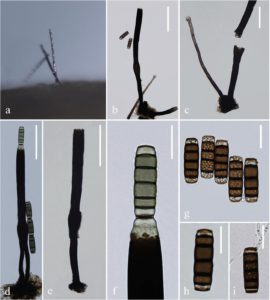Sporoschisma taitense (Mugambi & Huhndorf) A.N. Mill. IMA Fungus 7(1): 131–153 (2016)
Index Fungorum number: IF 916829; Facesoffungi number: FoF02375
Basionym: Melanochaeta taitensis, Sydowia 60 (2): 263 (2008)
Saprobic on submerged decaying wood. Sexual morph: Undetermined. Asexual morph: Colonies on the substratum superficial, effuse, gregarious, hairy, pale black. Mycelium immersed, composed of pale to dark brown hyphae. Setae scattered or in groups mixed with conidiophores, capitate, with hyaline, mucilaginous substances at the swollen apex, smooth-walled, pale brown, becoming paler towards the apex, straight or flexuous, 4 − 5-septate, 192 − 204 × 7.5–8.5 μm (x = 198×8 μm, n = 10). Conidiophores macronematous, mononematous, smooth, black, straight or slightly flexuous, solitary, each composed of a bulbous base, a cylindrical stipe and a swollen venter with a long cylindrical neck, erect, 298.5–321.5 μm long, 12–14 μm wide below venter and 16–19 μm wide above, 21.5–25.5 μm wide at venter. Conidiogenous cells monophialidic, integrated, terminal, determinate, brown. Conidia formed in chains, cylindrical to doliiform, 37–42 × 11.5–12.5 μm (x = 39.5 × 12 μm, n = 30), 5-septate, smooth, with conspicuously darkened septa, occasionally constricted at septa, center cells brown, end cells hyaline and shorter than the central four cells.
Material examined – CHINA, Yunnan Province, saprobic on decaying wood submerged in a stream in Cangshan Mountain, Oct. 2014, L.W. Wang, 3HLXM H 129–1, S-569 (DLU 272), living culture, KUMCC 15–0241, MFLUCC.
Notes – Réblová et al. (2016) combined Melanochaeta taitensis Mugambi & Huhndorf as Sporoschisma taitense (Mugambi & Huhndorf) A.N. Mill and did not provide the description and illustration for the asexual morph of this species. In this study, we provided the description and illustration for S. taitense. Sporoschisma taitense is morphologically most similar to S. nigroseptatum in having cylindrical to doliiform, 5-septate, smooth conidia with four inner cells dark brown and the two end cells hyaline to pale brown, but S. taitense differs from S. nigroseptatum in the conidia without conspicuous, spherical guttules in almost all cells. The phylogenetic analysis based on combined ITS and LSU sequence data also showed that our new strain clustered with S. taitense. Sporoschisma taitense was reported from Kenya (Mugambi and Huhndorf 2008) and this is the first record for China.
Fig 1. Sporoschisma taitense (DLU 272) a Colonies on wood. b, c Conidiophore with seta. d, e Conidiophore. f Portion of phialide producing conidia. g, h Conidia. i Germinated conidium. Scale bars: b, d, e = 100 μm, c = 50 μm, f–i = 20 μm.

